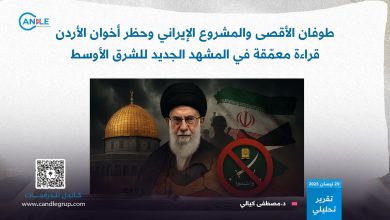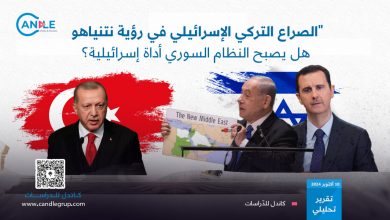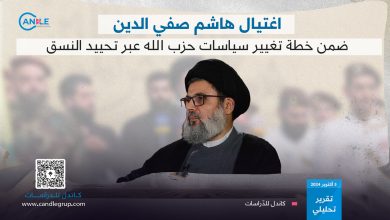The Sunni Tribal Belt Project in Eastern Syria
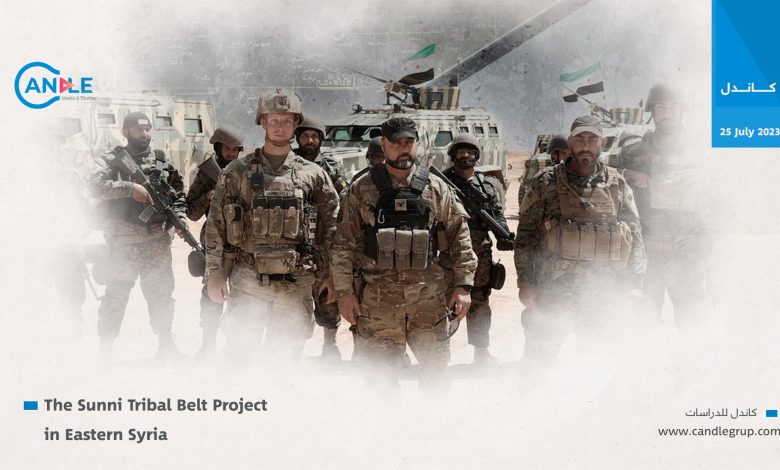
Introduction:
It is evident that the American strategy in Syria aims to exhaust all conflicting and warring parties since they all share hostility towards the United States. These parties include the Syrian regime, Iran and its proxies, ISIS, and Sunni revolutionary factions. However, the escalating attacks by Iranian militias against American bases, the failure of the SDF’s (Syrian Democratic Forces) project to impose its control over Syrian territory, the end of battles with ISIS after capturing its last strongholds in “Hajin” in Deir ez-Zor countryside, and the violation of rules of engagement between Russia and the United States in Syria have prompted the U.S. to reconsider this strategy. The U.S. now believes that confronting Iranian militias comes at a lower cost than containment and attrition. In this paper, we will examine the American project to form a Sunni tribal belt in Syria, followed by its extension into Iraq to undermine Iran’s influence and cut off its land corridor from Tehran to Beirut.
Learning from Iraq’s Mistakes:
Senior American leaders and strategists acknowledge that they made mistakes in Iraq by putting all their weight into supporting the Shia faction, which led Iraq to fall into Iran’s embrace. The oppression of Sunnis by Shia authorities also contributed to the rise of ISIS. Therefore, the Americans are now inclined to correct this mistake in Syria by avoiding putting all their support behind a single ethnic or sectarian group, particularly the Kurdish component([1]). To achieve this, they established what is known as the Syrian Democratic Forces (SDF), which brought together Arab components along with the Kurdish one. However, this new umbrella has not succeeded, as the Kurdish component remains dominant and in control. They hold the financial resources, authority, and power, and they have a strong grip on the top leadership positions, despite around 70% of SDF’s elements being Arab.
The United States started to sense the danger after the increasing oppression of Arabs within the Kurdish component of the SDF. This included forced conscription, kidnapping of girls for military service, and the closure of private schools that taught in Arabic. Moreover, a significant wing within the SDF is associated with the PKK (Kurdistan Workers’ Party), which has close ties to Iran and the Syrian regime, with “Jamil Bayak” leading the way. Turkey’s exploitation of this situation and its repeated threats of military operations against the SDF, aiming to undermine its control and influence, pushed the U.S. leadership to seriously consider forming a parallel Sunni tribal force to counterbalance the SDF.([2])
Al-Tanf Base:
Since its establishment in late 2015 ([3]), the declared objective of the Al-Tanf Base was to combat the Islamic State. However, its location at the intersection of the Iraqi, Jordanian, and Syrian borders, and the presence of multinational coalition forces, including American, British, and previously French forces, indicate that its purpose goes beyond merely fighting ISIS and drug networks. The base serves as a strategic point to hinder Iran’s project of dominating the Syrian desert and is intended to be used as a launching pad for future operations to undermine Russian influence and alter the dynamics of the conflict, as we will explain further.
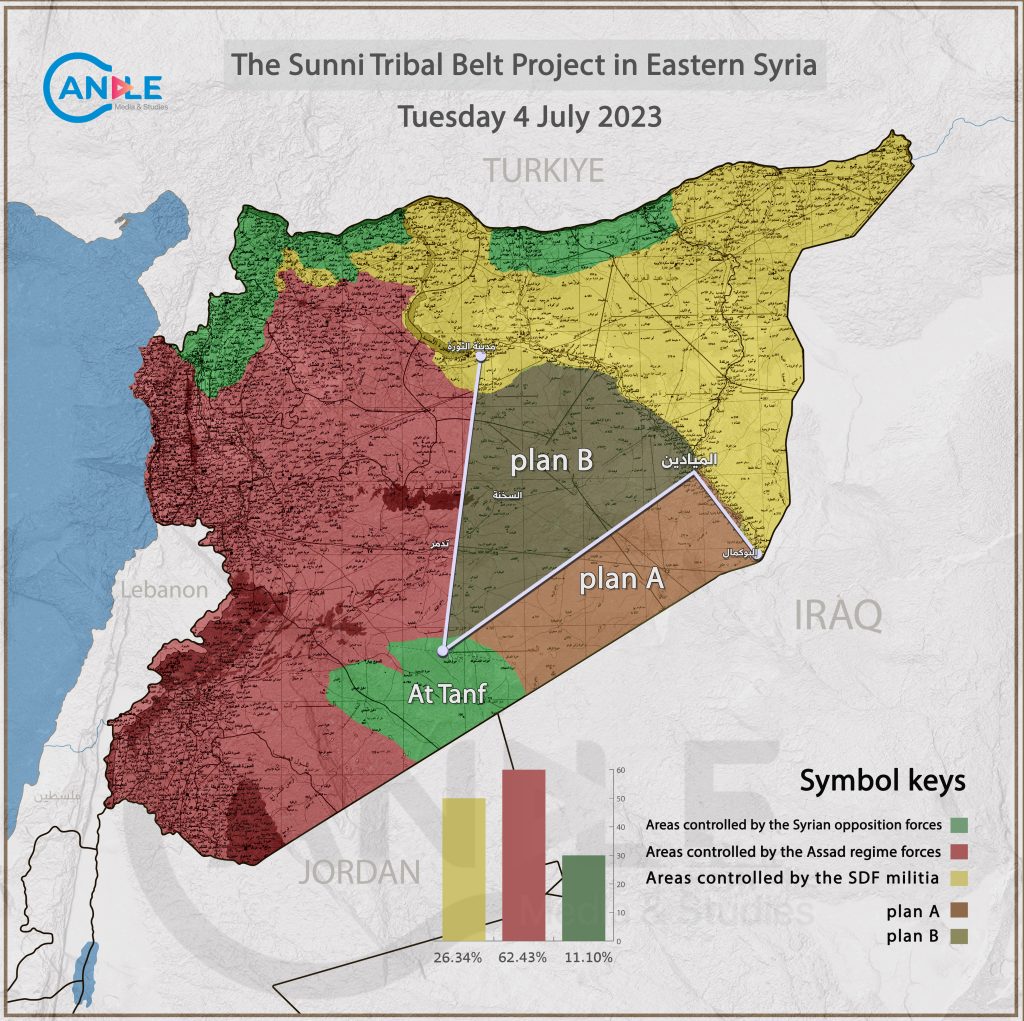
The New American Project:
The main features of the new American project (first proposed in 2020)([4]) are as follows: forming a Sunni Arab tribal force using existing Arab components within the Syrian Democratic Forces (SDF) and adding new tribal formations. This force will establish strong connections and coordination with the Al-Tanf Base. Subsequently, it will initiate a military operation to secure the Iraq-Syria border, starting from the Badia Al-Bukamal region and extending control over the border town of Al-Bukamal up to the Al-Tanf Base.
Motives and Reasons for the Project:
- The increasing attacks by Iranian militias using drones and missiles on American bases, with the most dangerous being the attack on the Kharab Al-Jir([5]) base in Al-Hasakah in April, which resulted in the death of an American contractor at the base.
- The discovery of an Iranian plan to attack American bases in Syria in coordination with Hezbollah to force the U.S. forces to withdraw from Syria. This plan was revealed by The Washington Post.
- The recent drone attacks by Iran on the Al-Tanf Base from the Iraq-Syria border, causing material losses and casualties among the Syrian factions operating in Al-Tanf, particularly the Maghaweir Al-Thowra forces.
- The increased military cooperation between Iran and Russia in Ukraine, coupled with Russia’s encouragement of Iranian militias to intensify their attacks on American forces at the Al-Tanf Base and other bases in Deir ez-Zor and Al-Hasakah.([6])
- The exhaustion of the SDF project and its inability to sustain itself, especially in Deir ez-Zor and Raqqa provinces. Additionally, there is growing resentment among Arab tribal communities towards the SDF due to its persecution of Arab components, its control over oil resources, and the escalation of frequent tribal protests against the SDF, particularly in Deir ez-Zor.([7])
Project Objectives:
The primary objective of the project is to sever the land corridor between Tehran and Beirut by gaining control over the Iraq-Syria border. Subsequently, the goal is to link the Al-Tanf Base with the American-allied forces composed of Arab tribes. This move serves as a pressure tactic on the SDF, which refuses to expand its military operations against Iranian militias and the Syrian regime due to the dominance of a pro-Iranian faction within the SDF’s leadership, as mentioned earlier.
Furthermore, the project will be expanded to include the line from Al-Tabqa to Al-Sukhna. However, Russia, after learning about the seriousness of the American project, requested the avoidance of any advancement towards the interior of Syria, specifically the area of Palmyra (Tadmur), as it is considered a purely Russian sphere of influence.
Long-term Objectives:
The long-term objectives of the American project involve finding a solution that benefits all parties involved in the conflict. Turkey stands to gain from this project by weakening the influence of the SDF and undermining its control over oil resources through the emergence of Arab tribal power. Israel will achieve its goal of cutting off Iran’s overland routes. Additionally, Turkey will benefit from the connection of a trade route between itself and Jordan through this region.
It appears that Turkey is involved in this project([8]). If successful, this project could form a nucleus for unifying the region between the Euphrates Shield and Olive Branch operations, and later extend to include Idlib. Consequently, the forces outside of the control of the Syrian regime and Iran would represent 50% of Syria’s map. Moreover, these areas in northeast Syria possess significant economic, wealth, and food resources. This would compel Russia to negotiate and relinquish its support for Bashar al-Assad, leading to the implementation of UN Resolution 2254, which is the ultimate goal of the American project.([9])
Project Obstacles:
The first obstacle for the United States is the fear of a potential aerial clash with Russia, especially after repeated Russian provocations over the Al-Tanf Base, as stated by the commander of the U.S. Central Command’s air forces.([10])
The second obstacle is the scarcity of fighters. After the Americans met with the commander of the SDF’s Al-Sanadid Forces, “Hmeida Al-Jarba,” he sent 1500 fighters from Al-Hasakah Governorate to Deir ez-Zor([11]), indicating the seriousness of the American project. However, the number of fighters in the Raqqa Revolutionaries Brigade (Ahmad al-Alosh Abu Issa) does not exceed 1000, and the Military Council of Deir ez-Zor, which the U.S. is restructuring([12]) and removing “Ahmed al-Khabil” from and appointing a new leader, might reach around 1500 fighters.
As for Al-Tanf forces, the total number of fighters in all their formations does not exceed: The Free Syrian Army, and the Lions of Al-Qaryatayn Brigade, except for 2,500 fighters. The approval to include the “Martyr Ahmed Al-Abdo” and the “Eastern Lions” factions has not been granted yet, and they together constitute around 1,000 fighters.([13])
Moreover, there are logistical obstacles still under consideration by the U.S. military command, such as whether they will control Deir ez-Zor Military Airport or be content with the current control over Al-Bukamal and Al-Mayadin. The military airport in Deir ez-Zor is considered a potential launch point for future intelligence operations against Iran and capable of receiving heavy American supply aircraft.
There is a team within the American administration supporting the expansion of the project to reach the Al-Tabqa and Al-Sukhna areas. They believe that Russia does not have vital interests in this region, as its interests extend from Tadmur (Palmyra) to the coast. However, another team sees the project’s current focus on controlling Al-Bukamal, Al-Mayadin, and the Iraq-Syria border as sufficient until additional forces are prepared, and they are keen on observing Russia’s reaction after this operation. The first team believes that gaining control over the area from the border to Al-Tabqa and Al-Sukhna, in conjunction with forming these Sunni tribal forces, aligns with the U.S. strategic goal. This could potentially lead to the formation of an Iraqi Sunni tribal force extending from Ramadi to Mosul, which aligns with the context of correcting the American mistake of putting all their support in one basket (the Kurds in Syria and the Shia in Iraq).([14])
Recommendations:
The question is no longer whether the United States will start this project or not, but rather when will this project be launched? There are several indications of the seriousness of the United States in this project, and we will highlight the most prominent ones:
- The meeting of the U.S. envoy “Nicholas Grinjger” with Arab tribal factions in the city of Al-Tabqa on May 8th.([15])
- The meeting of U.S. forces with Sheikh “Rafe Al-Haran” from the Shamar Arab tribe at the Al-Yaarubiya crossing.([16])
- The establishment of new U.S. military points on the Syrian-Iraqi border, totaling 25 points, according to the Anatolia Agency.([17])
- The meeting of U.S. forces with the leader of Raqqa’s rebels, Abu Issa, and the distribution of financial sums to his elements. This is the first time such a meeting has occurred since the formation of the Syrian Democratic Forces (SDF) in 2015.([18])
- The visit of the military engineering delegation to the bridge in the city of Al-Mayadeen, raising combat readiness at the Tanf base, establishing a military operations room with the “SDF” and the “Lions of Raqqa Brigade,” and the arrival of F22 Raptor aircraft to support this operation.([19])
Given the seriousness of the American project, we recommend the following:
- Engagement of all Syrian stakeholders, particularly the military, in this project.
- Establishment of a direct communication channel between the Al-Tanf Base and the northern Syrian factions, especially those from the eastern regions.
- Strong involvement of Turkey in this project to avoid a repeat of the mistake made in 2015 when Turkey refused to cooperate with northern Syrian factions in liberating Deir ez-Zor and Raqqa from ISIS, leading to these cities falling under SDF control.
- Formation of a tribal force from the factions in the eastern regions, independent of this movement, to avoid any potential concerns for the Americans, as certain factions from this movement are still listed by the U.S. Treasury Department.
- Financial support (salaries) for the Ahmad al-Abdo and Lions of the East factions while awaiting their official inclusion into the coalition forces at the Al-Tanf Base.
- Efforts to attract fighters who have moved to the southern area, some residing in the Rukban camp and others inside Jordan.
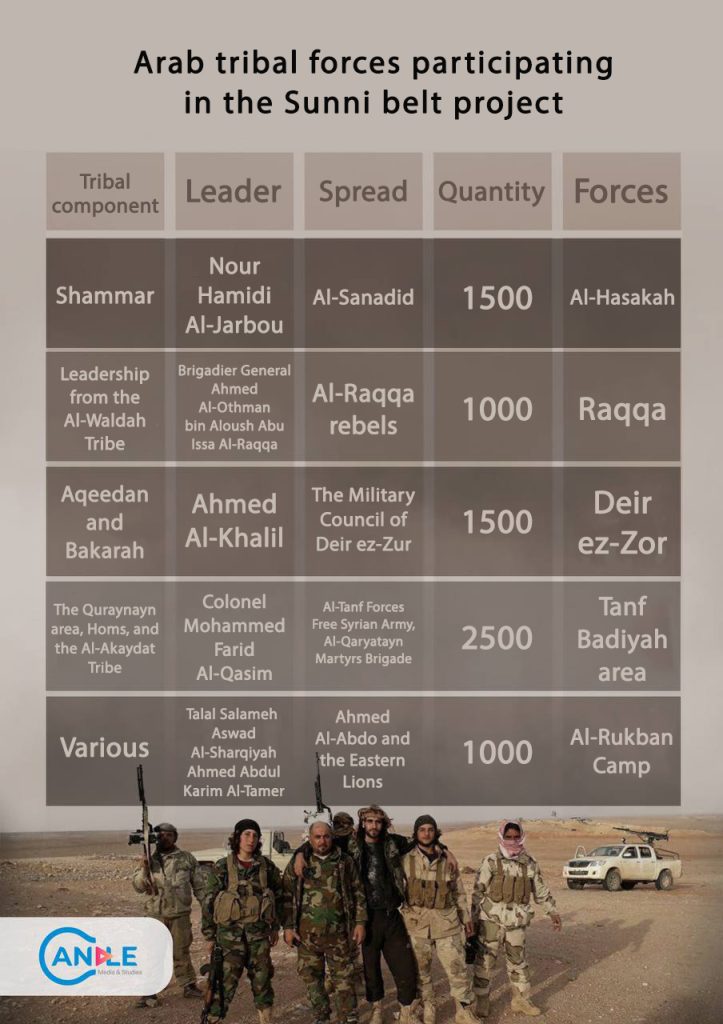
Conclusion:
Any military operation that leads to the liberation of new areas from the grip of the Syrian regime undermines Russian influence, curtails Iranian dominance, and expands the green area on the maps at the expense of the red. This, in turn, increases the influence of the revolution and thwarts the Arab normalization project with the regime, which would portray the regime as lacking control over additional territories and sovereignty.
Furthermore, this project can serve as a basis for forming a belt zone in the southern region (Daraa and Suwayda) with support from Jordan under the pretext of combating drug trafficking. Such a move would exert significant pressure on the Syrian regime and Russia to comply with the implementation of UN Resolution 2254 and the formation of a transitional governing body.
Moreover, this project contributes to gradually dismantling the SDF system and thwarting the separatist project by highlighting the power of these Sunni tribal forces. They would assume the responsibility of combating ISIS and Iranian militias, effectively serving as an alternative to the SDF.
The Sunni Tribal Belt Project in Eastern Syria
———————————————————-
[5] https://www.noonpost.com/content/47310
[6] Same as the previous source
[9] personal source for the researcher
[11] personal source for the researcher
[13] personal source for the researcher
[14] personal source for the researcher
[19] personal source for the researcher


